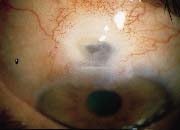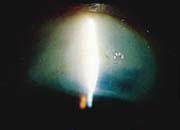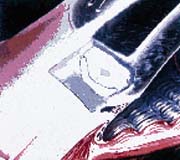Ab externo trab avoids complications of penetration
A simple technique to treat glaucoma can be performed without creation of a scleral flap.
We first performed nonpenetrating filtering procedures in 1969 with a technique initially called sinusotrabeculectomy. The first series of 59 cases with a follow-up of 5 years were presented as the named Colombian lecture of the Colombian Society of Ophthalmology in 1984. Since, we have continued to improve the technique with new concepts and modifications.
In 1991 we collected a second series of cases under the name ab externo trabeculectomy, in which a micro-diamond drill was added to the technique. From 1991 to 1994 we again modified the technique, removing the scleral flap after the microfiltration was obtained.
Filtering surgery even with modern techniques still poses the risk of serious intraoperative, early and late complications. Some of those complications are vision-threatening. Early surgery has been advocated by different authors, but still the risk of a flat anterior chamber and its consequences and the possibility of developing an early or late cataract keep many surgeons away from this type of treatment.
Avoiding complications
|
|
Most complications from traditional fistulizing glaucoma procedures arise from the opening of the anterior chamber. Shallow anterior chambers in the early postop period, if they last too long, are followed by serious complications such as iritis, acute lens opacification, cystoid macular edema, choroidal detachment or malignant glaucoma, all with consequences in visual acuity.
Anterior chamber decompression during surgery may be the cause of late development of lens opacification and cataracts. A national survey conducted in the United States compared the incidence of complications in 26,000 patients who underwent glaucoma surgery. Fistulizing procedures done with and without antimetabolites were analyzed. In the group with antimetabolites, choroidal detachments were found in more than 30% of patients, flat chambers in 25% and hypotonous maculopathy in 4%. A total of 33% of the cases with traditional fistulizing procedures lost one or more lines of visual acuity, as did 20% in the group with antimetabolites. Hypotony after the use of mitomycin has become a serious complication of modern trabeculectomy.
Noninvasive antiglaucoma surgery avoids most of those complications, because, being an extraocular procedure, the anterior chamber is not opened and low intraocular pressures (IOPs) after the surgery are rarely observed.
The overall results in our third series showed a small difference in the final success between our procedure and standard trabeculectomy. IOP lower than 21 mm Hg with the standard technique was achieved in 73% of cases, with the use of antimetabolites in 90% and with our technique in 80%. The lack of early and late complications and the easy possibility of performing a second non-penetrating procedure leads us to believe that ab externo trabeculectomy offers safer results to the patient.
Nonpenetrating ab externo technique
Ab externo surgery when performed for the first time in open-angle glaucoma should identify all the anatomical elements of Schlemm’s canal. Our goal should be to open Schlemm’s canal, remove the roof of the canal and remove the endothelial layer that covers the floor. This area should be large enough to re-establish a better outflow of aqueous and theoretically leave a permanent leakage of 100 µm.
|
|
Avoid as much as possible hemorrhage or excessive tissue manipulation or cauterization. Surgery is performed under local anesthesia. Proparacaine or similar drops are applied minutes before by placing a piece of Weck-cel sponge in the conjunctival area to be opened. The conjunctival tissue will impregnate with the anesthetic and the patient will feel no pain. A 27-gauge insulin needle, bent 45°, is used to penetrate the conjunctiva parallel to the sclera, avoiding contact with the episcleral vessels. Lidocaine 1 cc with epinephrine is injected under Tenon’s capsule.
Use a microscope with high magnification and establish a parallel plane between your eye and the surgical area. It is important that while microscopically identifying the different parts of Schlemm’s canal area you do not have oblique or unsteady positions of the canal. To achieve this parallel plane, anchor a 7-0 silk suture in the peripheral cornea a few millimeters away from the limbal area and deep into the stroma. This double suture is fixed outside the eye with a clamp, as a fixation string.
Conjunctival incision is started far away from the limbus near the fornix in order to have a big flap with the wound closure area separated from the fistulizing zone. Conjunctiva is dissected en block with Tenon’s capsule and retracted with a sponge all the way to the limbus. If this maneuver is done properly, not too much bleeding is observed and cautery is not necessary.
A second 7-0 silk suture is now placed, passing the needle throughout the Tenon’s capsule and fixing, too, with a forceps over the previous fixation suture. This new suture is very important to maintain the Tenon’s away from subsequent maneuvers and avoid any opening of the conjunctiva, which will cause a leaking of aqueous after filtration surgery is done.
|
|
We now have the limbal area ready for the trabeculectomy. With a razor blade or a diamond knife, a rectangular incision approximately 3 mm long and 1.5 mm wide is made, trying to arrive just at the external wall of Schlemm’s canal. This incision is 250 µm deep. Once the rectangle is marked, bipolar cautery is applied with two purposes. One is to avoid bleeding in the next steps and two is to shrink the borders of the rectangle and facilitate the further dissection of the flap.
With a blunt knife, ab externo dissection proceeds in one of the right short sides of the rectangle until aqueous flow is obtained. At this level, again from right to left (for right-handed surgeons) the flap is lifted, trying to follow a constant tissue plane to leave a regular bed un derneath and avoid irregularities that may promote excessive wound healing. If we have done a perfect dissection, we will find in the bottom the un roofed Schlemm’s canal and a permanent flow of aqueous. These man euvers should be performed under high magnification, with a completely dry surface and a very steady surgical field.
The surgery does not end here. What you have done up to now is unroofing Schlemm’s canal, but you have not yet eliminated the floor of the canal. Its en dothelial lining is where part of the physiologic obstruction of the aqueous is taking place in the glaucomatous open-angle glaucoma eye.
If Schlemm’s canal is not identified, continue deeper dissection with the blunt knife or with a diamond burr until you see it. If there are remnants of the canal’s roof, careful dissection of this tissue is performed. We have designed special scissors for this maneuver. At this point a small piece of Weck-cel sponge soaked with mitomycin is placed above the canal and covered by the conjunctiva that was held with the silk suture. We use mitomycin at a very low dose (0.08%), and at this moment there is no communication between the surgical area and the anterior chamber. We recommend leaving the sponge 2 minutes in thin and old conjunctiva and 3 or more minutes in thick or young tissues.
After time is checked, the sponge with mitomycin is removed. We do not wash thoroughly thereafter. The drug at this dose has never caused us any complications, and we think the tissue should stay impregnated.
Gauze is now placed covering the whole surgical area to guarantee there is no liquid flowing down to the surgical area, making a false impression about leakage from the anterior chamber.
The diamond burr is then carefully passed over the Schlemm’s canal floor two or three times until we observe a constant flow of aqueous from the anterior chamber. The surgery is then complete. Lifting of this endothelial layer can be also achieved with the help of special tiny forceps designed by Demailly and Valtot in Paris.
The left side of the scleral rectangular flap is removed, leaving the percolating area free of any protective scleral flap and covered afterwards with conjunctiva. The silk suture holding Tenon’s capsule is removed and the conjunctiva is carefully replaced, smoothing it with a sponge and identifying the epithelial border from Tenon’s capsule.
Suturing the conjunctiva is better achieved with a running mattress 9-0 nylon suture. If the case is properly done, a diffuse bleb can be observed 10 minutes after the conjunctiva is firmly closed.
Postop care
If the surgery ended without too much bleeding or complications, the patient can go home without any bandage or medications and can be examined 24 to 48 hours later. The next-day IOP should be below 8 mm Hg and above 4 mm Hg. If the IOP is higher than 10 mm Hg a gonioscopic lens — preferably a Ritch goniolens — should be placed and a trabeculolysis with YAG laser performed.
The trabeculolysis procedure is done easily. Once a good view of the surgical area under gonioscopy is obtained, one or two shots are usually enough to increase the connection between the anterior chamber and the bleb. Each shot measures approximately 50 µm, and we need a permanent opening of 100 µm. A successful YAG trabeculolysis requires a good bleb. Otherwise, you have to uncover the wound, return to the Schlemm’s canal area and determine if there is a blood clot or if you need to pass the diamond burr again.
IOP starts to rise slowly and by the end of the second week should be around 10 mm Hg. Conjunctival sutures should be left in at least 1 week and maximum 2 weeks after the procedure.
There are a few cases were the positive suction pressure of the bleb sucks iris tissue toward the gonioscopic filtration area, causing an immediate elevation of IOP. At gonioscopic examination the filtering area is found partially covered by iris tissue in a tent form. For those cases we recommend performing a synechialysis.
For Your Information:
- Eduardo Arenas MD, FACS, is a professor of ophthalmology at National University in Bogota, Colombia and associate chief, department of surgery, Fundacion Santa Fe de Bogota. He can be reached at Tr 21 No. 100-20, Bogota, Colombia; (57) 1-611-1711; fax: (57) 1-256-8274.
- M. Alexandra Mieth, MD, FARCCS, is an ophthalmologist CAFAM and is a consultant with the department of pathology, Fundacion Santa Fe de Bogota. He can be reached at Tr 21 No. 100-20, Bogota, Colombia; (57) 1-611-1711; fax: (57) 1-256-8274.
References:
- Arenas-Archila E. Ab externo trabeculectomy. Minihigh-letters of ophthalmology. 1991;19:50-66.
- Arenas E, Forero S. Microfresa de diamante para la trabeculectomía ab externo. Diseño de un instrumento. Soc Ecuatoriana de Oftalmologia. 1994;8:8-9.
- Inaba, Z. Long term results in trabeculectomy in the Japanese: analysis by life table method. Jpn Ophthalmol. 1982;26:361-373.
- Jampel HD, Pasquale LR, Dibernardo C. Hypotony maculopathy following trabeculectomy with Mitomycin C. Arch Ophthalmol. 1992;110:1049-1050.
- Knapp A, Heuer DK, et al. Serious corneal complications of glaucoma filtering surgery with postoperative 5-Fluorouracil. Am J Ophthalmol. 1987;103:183-187.
- Katz LJ, Cantor LB, Spaeth GL. Complications of surgery in glaucoma. Early and late bacterial endophthalmitis following glaucoma filtering surgery. Ophthalmology. 1985;92:959-963.
- Newhouse RP, Beyrer C. Hypotony as a late complication of trabeculectomy. Annals of Ophthalmology. 1982;685-686.
- Jay JL .Earlier trabeculectomy. Trans Ophthalmol Soc U K. 1983;103:35-38.
- Migdal C, Gregory W, Hitchings R . Long-term functional outcome after early surgery compared with laser and medicine in open-angle glaucoma. Ophthalmology. 1994;101:1651-1656.
- Garcia-Sanchez J, Arias-Puente A. Trabeculectomía precoz vs tardia en el tratamiento del glaucoma. Ann Inst Barraquer. 1995;25:2217-2223.
- Chauvaud D, Clay Fressinet C, et al. Opacification of the crystalline lens after trabeculectomy. Study of 95 cases. Arch Ophtalmol Rev Gen Ophtalmol. 1976;36:379-386.
- Wilensky JT, Chen TC. Long-term results of trabeculectomy in eyes that were initially successful. Trans Am Ophthalmol Soc. 1996;94:147-159; discussion 160-164.
- Kawase K, Nishimura K, et al. Anterior chamber reaction after mitomycin and 5 fluorouracil trabeculectomy: A comparative study. Ophthalmic Surgery. 1993;24:24-27.
- Sastry S, Street D, Javitt J. National outcomes of glaucoma surgery: complications following partial and full-thickness filtering procedure. J Glaucoma. 1992;1:137-140.
- Shields MB, Scroggs MW, et al. Clinical and histopathologic observations concerning hypotony after trabeculectomy with adjunctive mitomycin C. Am J Ophthalmol. 1993;116:673-683.
- Zacharia PT, Deppermann SR, Schuman JS. Ocular hypotony after trabeculectomy with Mitomicyn C. Am J Opthalmol. 1993;116:314-326.
- Arenas E. The role of non penetrating filtering operations in open angle glaucoma. Highlights of Ophthalmology. 2000;28:24-33.



